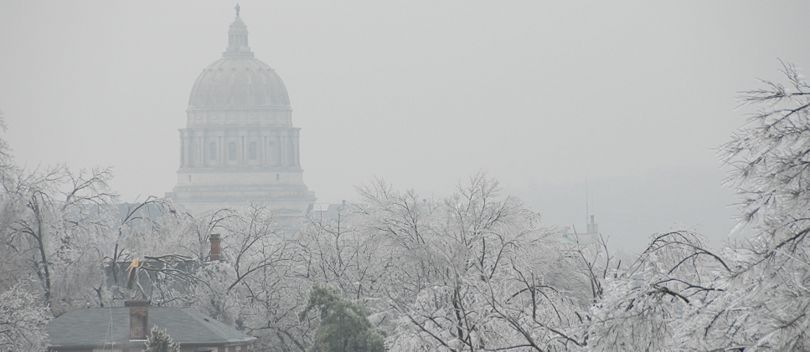903.14 Emergency Management Signing
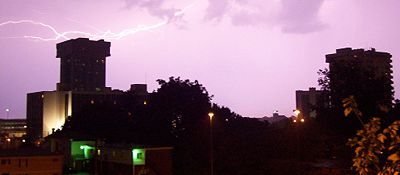
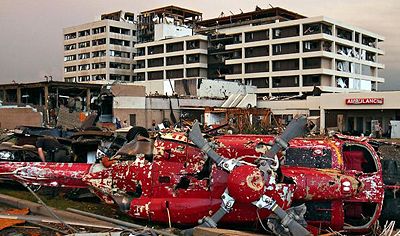
903.14.1 Emergency Management (MUTCD Section 2N.01)
Guidance. Contingency planning for an emergency evacuation should be considered by all state and local jurisdictions and should consider the use of all applicable roadways.
In the event of a disaster where highways that cannot be used will be closed, a successful contingency plan should account for the following elements: a controlled operation of certain designated highways, the establishment of traffic operations for the expediting of essential traffic and the provision of emergency centers for civilian aid.
903.14.2 Design of Emergency Management Signs (MUTCD Section 2N.02)
Standard. Emergency Management signs shall be used to guide and control highway traffic during an emergency.
Emergency Management signs shall not permanently displace any of the standard signs that are normally applicable.
Advance planning for transportation operations’ emergencies shall be the responsibility of state and local authorities. The federal government shall provide guidance to the states as necessitated by changing circumstances.
Except as provided in EPG 903.2.13, the sizes for Emergency Management signs shall be as shown in Table EPG 903.14.2.
Table 903.14.2 Emergency Management Sign Sizes
| Sign | Sign Designation | EPG Article | Conventional Road (in. x in.) | Freeway/Expressway (in. x in.) | ||
|---|---|---|---|---|---|---|
| Single Lane | Multi-Lane | Oversized | Mainline & Ramps | |||
| Evacuation Route | EM-1, EM-1a | 903.14.3 | 24 X 24* | 24 X 24* | - | 24 X 24 |
| Area Closed | EM-2 | 903.14.4 | 30 X 24 | 30 X 24 | - | 30 X 24 |
| Traffic Control Point | EM-3 | 903.14.5 | 30 X 24 | 30 X 24 | - | 30 X 24 |
| Maintain Top Safe Speed | EM-4 | 903.14.6 | 24 X 30 | 24 X 30 | - | 24 X 30 |
| Permit Required | EM-5 | 903.14.7 | 24 X 30 | 24 X 30 | - | 24 X 30 |
| Emergency Aid center | EM-6a to EM-6d | 903.14.8 | 30 X 24 | 30 X 24 | - | 30 X 24 |
| Shelter Directional | EM-7a to EM-7d | 903.14.9 | 30 X 24 | 30 X 24 | - | 30 X 24 |
| * A minimum size of 18 in. X 18 in. may be used on low-volume roadways or roadways with speeds of 25 mph or less | ||||||
| Notes: | 1. Larger signs may be used when appropriate | |||||
| 2. Dimensions are shown as width x height | ||||||
Support. EPG 903.2.13 contains information regarding the applicability of the various in Table 903.14.2.
Option. Signs larger than those shown in Table 903.14.2 may be used.
Guidance. As conditions permit, the Emergency Management signs should be replaced or augmented by standard signs.
The background of Emergency Management signs should be retroreflective.
Because Emergency Management signs might be needed in large numbers for temporary use during an emergency, consideration should be given to their fabrication from any light and economical material that can serve through the emergency period.
Option. Any Emergency Management sign that is used to mark an area that is contaminated by biological or chemical warfare agents or radioactive fallout may be accompanied by the standard symbol that is illustrated in the upper left corner of the EM-7c and EM-7d signs in Fig. 903.14.2.
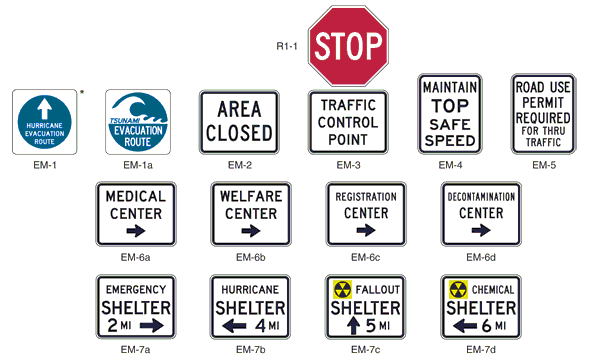
903.14.3 Evacuation Route Signs (EM-1) (MUTCD Section 2N.03)
Standard. The Evacuation Route (EM-1) signs shall display a blue circular symbol on a white square sign without a border. The EM-1 sign shall include a white directional arrow (except as provided below) and a white legend EVACUATION ROUTE within the blue circular symbol. The EM-1 signs shall be retroreflective.
Option. Instead of including a directional arrow within the blue circular symbol on the EM-1 sign, an Advance Turn Arrow (M5 series) or Directional Arrow (M6 series) auxiliary sign, but with a white arrow on a blue background instead of a black arrow on a white background, may be installed below the EM-1 sign.
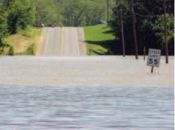
If desired, the word FLOOD or a word that describes some other type of evacuation route may be added as a third line of text above the white EVACUATION ROUTE legend within the blue circular symbol on the EM-1 sign.
An approved Emergency Management symbol with a diameter of 3.5 in. may appear near the bottom of an Evacuation Route sign.
Standard. The arrow designs, if used, on the EM-1 sign shall include a straight, vertical arrow pointing upward, a straight horizontal arrow pointing to the left or right or a bent arrow pointing to the left or right for advance warning of a turn.
If used, the Evacuation Route sign, with the appropriate arrow, shall be installed 150 to 300 ft. in advance of, and at, any turn in an approved evacuation route. The sign shall also be installed elsewhere for straight-ahead confirmation where needed.
If used in urban areas, the Evacuation Route sign shall be mounted at the right-hand side of the roadway, not less than 7 feet above the top of the curb, and at least 1 ft. back from the face of the curb. If used in rural areas, the Evacuation Route sign shall be mounted at the right-hand side of the roadway, not less than 7 ft. above the pavement and not less than 6 ft. or more than 10 ft. to the right of the right-hand roadway edge.
Evacuation Route signs shall not be placed where they will conflict with other signs. Where conflict in placement would occur between the Evacuation Route sign and a standard regulatory sign, the regulatory sign shall take precedence.
Option. In case of conflict with guide or warning signs, the Evacuation Route sign may take precedence.
Guidance. Placement of Evacuation Route signs should be made under the supervision of the officials having jurisdiction over the placement of other traffic signs. Coordination with Emergency Management authorities and agreement between contiguous political entities should occur to assure continuity of routes.
Option. The arrow may be a separate panel attached to the face of the sign.
903.14.4 AREA CLOSED Sign (EM-2) (MUTCD Section 2N.04)
Standard. The AREA CLOSED (EM-2) sign shall be used to close a roadway in order to prohibit traffic from entering the area. It shall be installed on the shoulder as near as practical to the right-hand edge of the roadway, or preferably, on a portable mounting or barricade partly or entirely in the roadway.
The sign shall consist of a black legend and border on a retroreflectorized white background.
Guidance. For best visibility, particularly at night, the sign height is not to exceed 4 ft. measured vertically from the pavement to the bottom of the sign. Unless adequate advance warning signs are used, it is not to be placed to create a complete and unavoidable blocked route. Where feasible, the sign should be located at an intersection that provides a detour route.
903.14.5 TRAFFIC CONTROL POINT SIGN (EM-3) (MUTCD Section 2N.05)
Standard. The TRAFFIC CONTROL POINT (EM-3) sign shall be used to designate a location where an official traffic control point has been set up to impose such controls as are necessary to limit congestion, expedite emergency traffic, exclude unauthorized vehicles or protect the public.
The sign shall be installed in the same manner as the AREA CLOSED sign (refer to EPG 903.14.4) and at the point where traffic must stop to be checked.
The standard STOP (R1-1) sign shall be used in conjunction with the TRAFFIC CONTROL POINT sign. The TRAFFIC CONTROL POINT sign shall consist of a black legend and border on a retroreflectorized white background.
Guidance. The TRAFFIC CONTROL POINT sign should be mounted directly below the STOP sign.
903.14.6 MAINTAIN TOP SAFE SPEED Sign (EM-4) (MUTCD Section 2N.06)
Standard. The sign shall consist of a black legend and border on a retroreflectorized white background.
Option. The MAINTAIN TOP SAFE SPEED (EM-4) sign may be used on highways where conditions are such that it is prudent to evacuate or traverse an area as quickly as possible.
Where an existing Speed Limit (R2-1) sign is in a suitable location, the MAINTAIN TOP SAFE SPEED sign may conveniently be mounted directly over the face of the speed limit sign that it supersedes.
Support. Since any speed zoning would be impractical under such emergency conditions, no minimum speed limit can be prescribed by the MAINTAIN TOP SAFE SPEED sign in numerical terms. Where traffic is supervised by a traffic control point, official instructions will usually be given verbally, and the sign will serve as an occasional reminder of the urgent need for maintaining the proper speed.
Guidance. The sign should be installed as needed, in the same manner as other standard speed signs.
Standard. If used in rural areas, the MAINTAIN TOP SAFE SPEED sign shall be mounted on the right-hand side of the road at a horizontal distance of not less than 6 ft. or more than 10 ft. from the roadway edge, and at a minimum height, measured vertically from the bottom of the sign to the elevation of the near edge of the traveled way, of 5 feet. If used in urban areas, the minimum height, measured vertically from the bottom of the sign to the top of the curb, or in the absence of curb, measured vertically from the bottom of the sign to the elevation of the near edge of the traveled way, shall be 7 ft., and the nearest edge of the sign shall be not less than 1 ft. behind the face of the curb.
903.14.7 ROAD (AREA) USE PERMIT REQUIRED FOR THRU TRAFFIC Sign (EM-5) (MUTCD Section 2N.07)
Standard. The sign shall consist of a black legend and border on a retroreflectorized white background.
Support. The intent of the ROAD (AREA) USE PERMIT REQUIRED FOR THRU TRAFFIC (EM-5) sign should notify travelers of the presence of the traffic control point so that those who do not have priority permits issued by designated authorities can take another route, or turn back, without making a needless trip and without adding to the screening load at the post. Local traffic, without permits, can proceed as far as the traffic control post.
Standard. If used, the ROAD (AREA) USE PERMIT REQUIRED FOR THRU TRAFFIC (EM-5) sign shall be used at an intersection that is an entrance to a route on which a traffic control point is located.
If used, the sign shall be installed in a manner similar to that of the MAINTAIN TOP SAFE SPEED sign (refer to EPG 903.14.6).
903.14.8 Emergency Aid Center Signs (EM-6 SERIES) (MUTCD Section 2N.08)
Standard. In the event of emergency, state and local authorities shall establish various centers for civilian relief, communication, medical service, and similar purposes. To guide the public to such centers a series of directional signs shall be used.
Emergency Aid Center (EM-6 series) signs shall carry the designation of the center and an arrow indicating the direction to the center. They shall be installed as needed, at intersections and elsewhere, on the right-hand side of the roadway, in urban areas at a minimum height, measured vertically from the bottom of the sign to the top of the curb, or in the absence of curb, measured vertically from the bottom of the sign to the elevation of the near edge of the traveled way, of 7 ft., and not less than 1 ft. behind the face of the curb, and in rural areas at a minimum height, measured vertically from the bottom of the sign to the elevation of the near edge of the traveled way, of 5 ft., and at a horizontal distance of not less than 6 ft. or more than 10 ft. from the roadway edge.
Emergency Aid Center signs shall carry one of the following legends, as appropriate, or others designating similar emergency facilities:
A. MEDICAL CENTER (EM-6a)
B. WELFARE CENTER (EM-6b)
C. REGISTRATION CENTER (EM-6c)
D. DECONTAMINATION CENTER (EM-6d)
The Emergency Aid Center sign shall be a horizontal rectangle. Except as provided below, the identifying word and the word CENTER, the directional arrow, and the border shall be black on a white background.
Option. When Emergency Aid Center signs are used in an incident situation, such as during the aftermath of a nuclear or biological attack, the background color may be fluorescent pink.
903.14.9 Shelter Directional Signs (EM-7 SERIES) (MUTCD Section 2N.09)
Standard. Shelter Directional (EM-7 Series) signs shall be used to direct the public to selected shelters that have been licensed and marked for emergency use.
The installation of Shelter Directional signs shall comply with established signing standards. Where used, the signs shall not be installed in competition with other necessary highway guide, warning, and regulatory signs.
The Shelter Directional sign shall be a horizontal rectangle. Except as provided below, the identifying word and the word SHELTER, the directional arrow, the distance to the shelter, and the border shall be black on a white background.
Option. When Shelter Directional signs are used in an incident situation, such as during the aftermath of a nuclear or biological attack, the background color may be fluorescent pink. The distance to the shelter may be omitted from the sign when appropriate.
Shelter Directional signs may carry one of the following legends, or others designating similar emergency facilities:
A. EMERGENCY (EM-7a)
B. FALLOUT (EM-7c)
C. CHEMICAL (EM-7d)
If appropriate, the name of the facility may be used.
The Shelter Directional signs may be installed on interstates or any other major highway system when it has been determined that a need exists for such signs as part of a state or local shelter plan.
The Shelter Directional signs may be used to identify different routes to a shelter to provide for rapid movement of large numbers of persons.
Guidance. The Shelter Directional sign should be used sparingly and only in conjunction with approved plans of state and local authorities.
The Shelter Directional sign is not to be posted more than 5 miles from a shelter.
